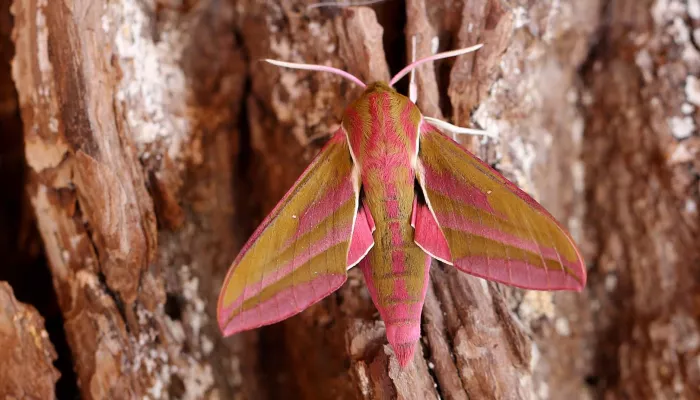Six-spot burnet moth
The six-spot burnet moth is a day-flying moth that flies with a slow, fluttering pattern. Look for it alighting on knapweeds and thistles in grassy places. It is glossy black, with six red spots on each forewing.

What species of butterflies can you find in and around Kent? Check out our species explorer pages and learn how to identify these marvellous insects!
The six-spot burnet moth is a day-flying moth that flies with a slow, fluttering pattern. Look for it alighting on knapweeds and thistles in grassy places. It is glossy black, with six red spots on each forewing.
A small, day-flying moth that can often be seen visiting garden herbs.
The brimstone moth is a yellow, night-flying moth with distinctive brown-and-white spots on its angular forewings. It frequently visits gardens, but also likes woods, scrub and grasslands.
The peppered moth is renowned for its markings that have evolved to camouflage it against lichen in the countryside and soot in the city. It can be seen in gardens, woods and parks, and along hedgerows.
The magpie is a distinctive moth with striking black and yellow spots on white wings. It is a frequent garden visitor, but also likes woodland, scrub and heathland.
This sooty-black, day-flying moth is active on sunny days, rarely settling in one place for long.
This birch-loving moth can be seen flying on sunny days in early spring.
This striking black-and-white moth flies during the day in open woodlands, moorlands, and bogs. It's most common on Scottish moors.
This large green moth rests with its wings spread, so is sometimes mistaken for a butterfly.
With a torpedo-shaped body and long, narrow wings, the privet hawk-moth is a striking garden visitor. But the caterpillars really stand out: lime-green, with purple streaks and a black hook at the tail end.
The lime hawk-moth is a large, night-flying moth that can be seen from May to July in gardens, parks and woods. It is buff-coloured, with green patches on its scalloped-edged wings.
The humming-bird hawk-moth migrates to the UK from Southern Europe each year. It can be seen hovering over flowers, feeding with its long proboscis; its wings move so quickly that it 'hums'.
The broad-bordered bee hawk-moth does, indeed, look like a bee! A scarce moth, mainly of Central and Southern England, it feeds on the wing and can be seen during spring and summer.
The elephant hawk-moth is a pretty, gold-and-pink moth that can be seen at dusk in gardens, parks, woods and grassy habitats. The caterpillars look like elephant's trunks and have eyespots to scare off predators.
Found almost everywhere, the large yellow underwing is a night-flying moth that is often attracted to lights. It is brown with orangey-yellow hindwings.
The Silver Y migrates to the UK in massive numbers each year - sometimes, an estimated 220 million can reach our shores in spring! Seen throughout the year, it is very common in gardens and grasslands.
The angle shades can be well-hidden among the leaf litter - its pinky-brown markings and scalloped wings giving it the perfect camouflage. It is on the wing in gardens, woods and hedgerows from May.
A very rare species, this moth is now limited to one site in the UK. Males can be a striking reddish buff in colour.
A common moth across most of the UK. The large, hairy caterpillars are often seen in late summer.
You're more likely to see the attractive, brightly coloured caterpillars than the mullein moth itself.
It is so easy to miss this clever little moth. It is a master of disguise, blending in perfectly as it looks just like the twig of a birch tree! Flying only at night, the buff-tip moth can be seen from May to July.
The puss moth is a large and fluffy moth, with a very strange looking caterpillar.
An unmistakeable insect of heaths, sand dunes and grasslands, the Emperor moth is fluffy, grey-brown, with big peacock-like eyespots on all four wings. Males can be seen during the day, but females lie low.
The garden tiger is an attractive, brown-and-white moth of sand dunes, woodland edges, meadows and hedgerows; it will also visit gardens. In decline, it is suffering from the 'tidying up' of our countryside.
These pretty black and red moths are often confused for butterflies! Their black and yellow caterpillars are a common sight on ragwort plants. The caterpillar’s bright colours warn predators not to eat them, giving a strong signal that they are poisonous!
The mohawk-sporting caterpillar of this moth is often seen on shrubs and trees in late summer. As adults the orange-brown males fly by day, but the flightless females don't stray far from their cocoon.
This striking day-flying moth is named after a 16th century witch.
This day-flying moth is found on flowery meadows, often in the company of other moths and butterflies.
This large, fluffy-legged moth is often attracted to lights in May and June.
The caterpillars of this fluffy white moth are best admired from a distance, as their hairs can irritate the skin.
This snowy white moth is easily mistaken for the similar brown-tail, until it lifts its abdomen to reveal a burst of golden-yellow.

This beautiful moth is often found resting on leaves, though it does also fly during the day.
This unmistakable moth spends the winter as an adult, tucked away in a sheltered spot like a cave or outbuilding.